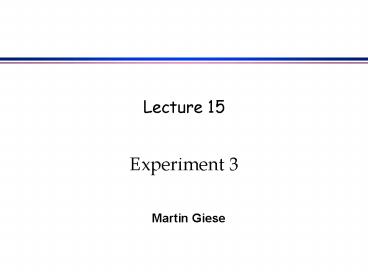Lecture 15 Experiment 3 - PowerPoint PPT Presentation
1 / 16
Title:
Lecture 15 Experiment 3
Description:
Measure Hysteresis Loop. Aspect Ratios: 0.5, 0.75, 1, 1.2, 1.5, 2 ... Measure Hysteresis Loop. Register if subject saw at least one perceptual switch during the trial ... – PowerPoint PPT presentation
Number of Views:27
Avg rating:3.0/5.0
Title: Lecture 15 Experiment 3
1
Lecture 15Experiment 3
- Martin Giese
2
Programming the Experiments
3
DrawPoints
High-level function that plays a movie with
dots DrawDots(f, A, t) plays sinusoidal tone
with frequency with frequency f
and amplitude A for t seconds Playsound(f, A, t,
An, fn, Bn) plays sinusoidal tone with band pass
background noise with mid frequency fn and band
width /-Bn
4
Reading In Key Presses
Simple example function
function key_demo() initialization ret_
strg wait for a valid key
press while strcmp(ret_strg, 'a', 'l') 0,
disp('Enter String.) ret_strg
getchar end actions for admissible
letters a and l if strcmp(ret_strg, 'a') 1,
disp('A') elseif strcmp(ret_strg, 'l')
1, disp('L') end
5
Data Analysis
6
Data Analysis
- Thresholds from probability data
- 50 threshold
- Cool (optional) fit logistic threshold function
- Thresholds directly from adjustment methods /
stair case - Statistics for comparing thresholds
- t-test (pairwise comparisons) if enough items
watch for (de)pendent measures ! - non-parametric test for few items
- ANOVA (next lecture)
- Extremely cool (idea for final project)run 2AFC
experiment and estimate d
7
Data Analysis
- Correction of the a level
- Problem test difference between 2 AFs
- Given N threshold values for K values of the
frequency ?? Akn and Akn - Possibilities
- t-test (pairwise comparisons) ? K independent
tests - Better ANOVA (next lecture !)
- How can we combine the results from K independent
tests?
8
Data Analysis
- P(single test significant even though H0 true) lt
a - P(single test non-significant if H0 true) gt 1-
a - Tests independent
- P(all K tests non-significant if H0 true) gt (1-
a)K - P(at least one out of the K tests significant if
H0 true) lt 1 - (1- a)K aeq
9
Data Analysis
Equivalent significance level for K independent
tests aeq 1 - (1- a)K ?? a 1 - (1-
aeq)1/K For large K a ? aeq/K (Bonferoni
correction)
Example K 4 aeq 5 a 1.27
10
Experiments
11
Measuring Percept Probability Dependent on Aspect
Ratio
- Aspect Ratios 0.5, 0.75, 1, 1.2, 1.5, 2
- 3 display cycles
- Register if subject saw horizontal or vertical
motion or the whole trial - Neglect trials with a perceptual switch
- Calculate percept probabilities
- 30 repetitions per condition
- 3 subjects
12
Measure Switching Probability Dependent on Aspect
Ratio
- Aspect Ratios 0.5, 0.75, 1, 1.2, 1.5, 2
- 6 display cycles
- Register if subject saw at least one perceptual
switch during the trial - Calculate switching probabilities
- 20 repetitions per condition
- 3 subjects
13
Measure Hysteresis Loop
- Aspect Ratios 0.5, 0.75, 1, 1.2, 1.5, 2
- Ascending and descending series
ascending 0.5-0.75 0.5-0.75-1 0.5-0.75-1-1.2
0.5-0.75-1-1.2-1.5-2
descending 2-1.5 2-1.5-1.2 2-1.5-1.2-1
2-1.5-1.2-1-0.75-0.5
14
Measure Hysteresis Loop
- Register if subject saw at least one perceptual
switch during the trial - Plot P(horizontal was seen in ascending trials)
and 1-P(vertical was seen in descending trials) - Quantify area of the loop
- 20 repetitions per condition
- 3 subjects
15
Quantify Visual Inertia
- Prime quartet with motion that forms angles a
and 90o- a with the sides of the quartet - Angles 0, 15, 30, 45, 60, 75, 90o
- Vary aspect ratio of the quartet in a staircase
- 5 reversals of change of the AR
- titrate the influence of the priming stimulus
against the change of the aspect ratio (AR) of
the quartet
16
Quantify Visual Inertia
- Use deviation from aspect ratio without priming
as measure for priming effect - 1 repeat per subject
- 3 subjects































